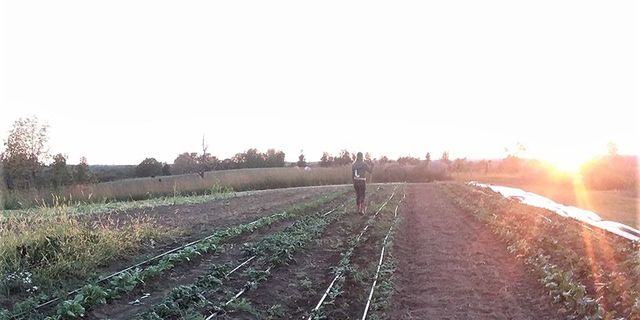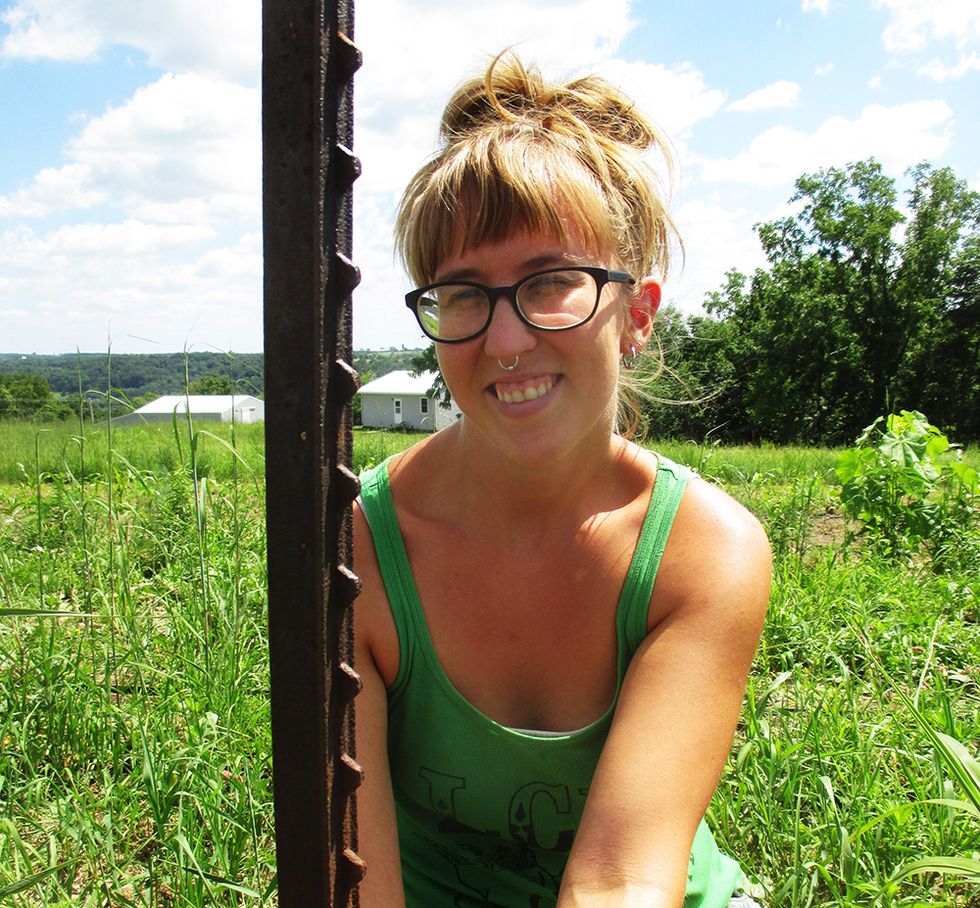It’s early Saturday morning. When the clock hits 7 AM, farmers market goers will arrive, trickling through empty streets before summer’s sun touches nearby rooftops. By 6:50, my stand and produce are all set up. I have 10 minutes to kill, so I peek at my phone behind the table.
Related: The Coming Agricultural Crisis—And 8 Things You Can Do About It Right Now
I read a comment on an Instagram photo of our farm: “Beautiful—so jealous of farm life!” My husband and I own a small, diverse vegetable farm in Iowa called Jupiter Ridge. We post photos on social media of our freshly picked produce, rows of sustainably-grown food, and stunning farm views to market ourselves. But like everything on social media, pictures don’t show the whole reality.
The Tough Reality You Don’t See On Instagram
By the time market customers show, I’ve been awake since 4 AM. I left the house around 5, driving an hour to market. The night before I’m up picking vegetables and packing coolers until 10 PM, sometimes even later. Friends have learned that inviting us out Friday nights is a long shot. Later we see their social media photos of summer vacations—something not possible or affordable in our lives.
7 AM arrives, with eager customers right on time. I’m running on four to five hours of sleep at this point. Conversations with me may seem curt, but it’s certainly not for lack of enthusiasm. In these moments I recall correspondences with fellow farmers like Nicki Morgan, 30, part-owner of HartBeet Farm in Missouri, for camaraderie and inspiration. I interviewed Morgan with others for a Guardian piece about young Midwestern small farmers, where she described her farm start-up.
Related: 5 Ways To Support Small Farmers Every Day
“To pay our bills, my wife worked full-time off farm,” Morgan said. “She spent 3 hours a day, 5 days a week commuting to St. Louis to work. There are very few decent jobs with decent wages in our [rural] area. This is a huge struggle for us.”
Like Morgan’s wife, part-owner Katie Hochstedler, I also work almost full-time off-farm. Every other spare hour goes toward helping my husband make our farm profitable, pushing my work week over full-time. Sometimes I forsake days off.
“Farm work is quite demanding,” agreed Morgan. “Compared to my peers…we have way less free time.” Talking to her recently, she said things have improved, however. “Katie has recently found a job closer to home with a much shorter commute, which does allow her a little more time for farm work…but Katie’s new job is still less than ideal.”
Small, Sustainable Farmers Have It Even Harder
Morgan and Hochstedler’s story—and mine—are typical of most market farmers you’ll meet. Small family farmers put loads more physical labor into acreage that’s a fraction of the size of most conventional industrial farms—especially if they want to grow sustainably and organically. They also make way less money and meager standards of living in comparison.
Related: 4 Million Acres Of Farmland Could Disappear—Unless This Woman Gets Her Way
According to recent USDA census data, the number of farms smaller than 50 acres shrank by 40,000 between 2007 and 2012. Farms larger than 2,000 acres added an additional 2,000 acres their ranks, however. That’s over 4 million acres in growth—while smaller farms disappeared. The average income for any size farm? Almost $200,000. But the census showed that average sales from farms selling products direct for human consumption—which tend to be small farms—was only about $9,000. Farming as an industry makes money, but small food farms clearly aren’t getting that cut. You could make more money working retail at Walmart.
My 2-acre farm faces these challenges. Though none have yet swallowed up the joys, I can’t say I’ve faced the worst. Immigrants, women, and farmers of color face discrimination, lack of capital and land access, and difficult entry into one of the whitest, most male careers in America, according to 2016’s Bureau of Labor Statistics report. There’s also a high incidence of severe mental health issues among farmers—higher than military veterans—due to lack of resources and government support.
Related: 3 Reasons Growing The Same Crop Every Year Is Bad For Organic Farms
All these are what farmers face to grow healthy food, and it’s ironic. It also shows in today’s farmer population, which is shrinking rapidly with most farmers nearing retirement. This could land us in an agricultural food system crisis before too long. Challenges are far too great to adequately mobilize another farming generation and draw people to the field, which is also ironic when farms are idealized as bucolic and peaceful.
But Let Me Assure You, It’s Not All Dark And Scary—And Every Minute Is Worth It
But for the sake of farmers and our food system—and in my young farmer’s perspective—we can’t afford to stop picturing farm life as idyllic. Farming is a lifestyle that will take your breath away. We can’t lose sight of that.
I certainly haven’t yet, with farming’s joys still going strong around me. I exchanged city life for constant immersion in nature and its cycles almost ten years ago, and I will never trade it back. I move my body every day, smelling earth and feeling sunshine. Sure, I ache when the day is done, but I feel more alive than I ever did in an office. I can’t afford that summer vacation, let alone leave for one during the growing season, but I’ve created a life I don’t feel I need a vacation from—and for farmers, there’s always winter. I never wonder if I’m getting enough exercise or healthy food.
Related: I Left My Job In Finance To Become A One-Woman Creamery
But the ultimate joy, however, is never doubting whether life has purpose. Despite its many challenges, farming yields joys that far outweigh its adversities. I’m not the only farmer who agrees. Jonathan Yagla, 34, and urban farmer and owner of The Millet Seed in Iowa City, Iowa, believes similarly.
“I can’t claim to be happier than the average person but I do feel like I am living an authentic life of great quality,” he said. “I make significantly less money than my peers. But I can’t imagine doing anything else at this point in my life. My schedule is dictated by the seasons, rather than corporate America.”
Ask farmers about their greatest challenge imaginable, and it may not be day-to-day, finances, or mental health. It may be the thought of ever returning to that office again. The Washington Post reported recently that thousands of young people are feeling this way, leaving comfortable jobs for the farm. This, to me, is a bright hope.
Related: In The Next 5 Years America Will Need A Million New Farmers—Could Army Vets Help Fill The Gap?
“If I do not do the work that is needed to live, someone else will take on that burden for me, and likely, at an unfair price,” Yagla said on why he took up the task of growing food sustainably on a small scale. The more farmers like this join us, undaunted by farming’s challenges, the easier it will get for all of us, whether we’re farmers, consumers, or anyone who values healthy food.
It’s noon—farmers market ends. I’ve been up 8 hours, but the day is far from done. I pack up and drive the hour home. I’d love a nap, but getting home means unloading, more planting, more fieldwork, and possibly working at my other job well into the evening. It’s challenging—but more challenging to me is the thought of ever stopping.














